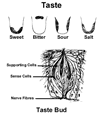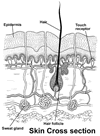Smell
Our sense of smell warns us about approaching danger (e.g. fire) and possible
food poisoning ("off fish! Phew!"). It also aids digestion (yummy
odours stimulate salivation) and can heighten sexual awareness.
 The smell receptors of the nose are sensitive to chemicals present
in a gaseous state. As the chemicals dissolve in the mucous lining of
the nasal passage, they stimulate sensory receptors which send electrical
impulses via nerve cells in the olfactory nerve to the brain. In the brain
these electrical messages are interpreted so that we can distinguish the
type and strength of the smell .
The smell receptors of the nose are sensitive to chemicals present
in a gaseous state. As the chemicals dissolve in the mucous lining of
the nasal passage, they stimulate sensory receptors which send electrical
impulses via nerve cells in the olfactory nerve to the brain. In the brain
these electrical messages are interpreted so that we can distinguish the
type and strength of the smell .
Taste
The tongue is the organ of taste having receptors which are sensitive
to chemicals in a liquid or soluble form.
 There
are separate taste buds for each of the four different pure taste sensations:
sweet, salty, sour, and bitter.
There
are separate taste buds for each of the four different pure taste sensations:
sweet, salty, sour, and bitter.
These different taste buds are concentrated in specific areas of the tongue. Any foods with unusual or "bad" tastes can be spat out before swallowing, preventing spoiled or poisoned food entering and harming our digestive system.
The sense we call taste is usually a combination of taste and smell. Pure sugar would be tasted on the tongue alone, but more complex tastes are mainly sensed by the nose. Many foods taste very bland when the nose is blocked with a head cold.
When different chemicals stimulate the nerve endings in the taste buds and smell receptors, electrical impulses pass to the brain which recognises the various combinations of tastes in relation to prior experience e.g. coffee, banana or peach.
People's sensitivity to detecting tastes reflects their overall number of taste buds, though recognition of minor taste variations (such as in wine-tasting) involves learning too!
Touch
 The skin is the organ of touch. In the underlying dermis layer are
located many different touch receptors sensitive to heat, cold, touch,
pressure and pain.
The skin is the organ of touch. In the underlying dermis layer are
located many different touch receptors sensitive to heat, cold, touch,
pressure and pain.
The distribution of receptors varies, with the fingertips having an abundance of touch and pressure receptors. This is of great survival benefit as it aids maximum sensitivity during delicate and intricate hand movements, which are a truly human feature, allowing the use of tools and writing. Similarly, it is advantageous to have fewer receptors on the soles of the feet so that walking on rough surfaces is not too painful.
"Pain" is the body's warning mechanism of danger and possible damage. Messages from the various sensory receptors travel to the brain which registers the location and extent of the painful stimulus.
Local anaesthetics work by dulling the nerve cells in a particular area. For example, a dental anaesthetic allows a dentist to drill painlessly in preparation for a filling. The impulses cannot get through to the brain so no pain is registered or felt.
Some pain-relief tablets work by raising the threshold of pain in the pain centre of the brain: a much stronger pain stimulus is needed before the brain "feels" it. Other medications can reduce transmission of signals to the brain.
| Copyright owned by the State of Victoria (Department of Education and Early Childhood Development). Used with Permission. |